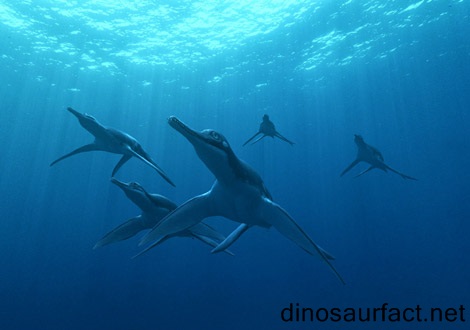 Click to visit the previous Marine Specie bio
Click to visit the previous Marine Specie bio
 |
|
 |
|
Kingdom: Animalia
Phylum: Chordata
Class: Reptilia
SuperOrder: Sauropterygia
Order: Plesiosauria
Family: Polycotylidae
Genus: Dolichorhynchops
 |
|
 |
|
 |
|

Of the many pre historic beasts that used to roam the land in the Jurassic Period, there were many, who used to roam the depths of the water as well. Adept predators, these water monsters, used to rule a world of their own. The Dolichorhynchops was one such creature, who used to lurch in the watery depths during the Jurassic age.
What was the Dolichorhynchop?
The Dolichorhynchop, was an Archosaur. Archosaurs, in today’s era, are represented by the crocodilian family. The Dolichorhynchops was a short-necked archosaurian that, like the many flightless birds today, used its paddle like features to sail through the waters. These marine reptiles were fast and were agile underwater acrobats, with bulging eyes giving it an even better look at its potential prey. It’s mouth was full of threatening 30- 40 teeth that made this monster all the more menacing. The long row of teeth ensured, that the prey had absolutely no chance to escape, and was thus, consumed wholly.
Dolichorhynchops grew twelve to fifteen feet (4 to five meters) long and was most likely lined in plush skin. It’s paddles were not feathery like those of the birds we see today. Instead, the paddles were stiff and hard, thus, proving to be not very useful on the land. Their importance was limited to the water.
The Dolichorhynchop was a skilled underwater hunter. Moreover, it was a skilled deep sea diver as well. However, a constant need for fresh air, must’ve forced it to spend most of its time near the surface, so that it could breathe in some fresh air as and when it required it.
This short necked reptile, had few enemies. But the lesser the enemies, the more ferocious they were. Hunters that hunted down the Dolichorhynchops constituted of ferocious sharks and other marine predators.
One discovered fossil of the reptile, had a young specimen of the species, inside it. Dolichorhynchops fossils have also been found with unborn babies within, which is proof enough of them having given birth to young ones.
The discovery
It was a young George f Sternberg who’d stumbled upon a Dolichorhynchops specimen in the Logan county, in Kansas in the year 1900.
His father had helped him collect the remains. They then sold the fossil to the University of Kansas.
For the lack of a better name, the fossil was named “KUVP 1300” till it was renamed by Dr. prophet Wendell Williston in the year 1902. Moreover, apart from naming the fossil, Williston also offered in-depth descriptions and new images. The specimen, has been on display ever since.
It was in the year 1918, that Charles H. Sternberg stumbled upon an exceptionally large mosasaur, Tylosaurus, that had the remains of another reptile in its abdomen. The discovered specimen, along with the archosaurian remains, is presently displayed in the U.S National repository. Though, these vital specimens were shortly reported the knowledge was lost to science till 2001. This specimen was re-discovered and delineated in the year 2004.
The appearance
The look of the Dolichorhynchops bears a close resemblance to that of the long turtleneck pliosaurs of the first Jurassic age like the “Macroplata” and “Rhomaleosaurus”.
The jaws of Dolichorhynchops aren't thought to have possessed an intense bite force
The Dolichorhynchops fact diary
- While humans have seven neck vertebrae, the Dolichorhynchops had three times as many.
- This prehistoric craniate lived throughout the age of the dinosaurs (the Late Cretaceous) in the same part of the planet which has today come to be known as Kansas, USA. However, that area was actually a vast ocean in the pre-historic era.
- It used four long paddled flippers to navigate graciously through the water, and was helped in this purpose by a smooth-skinned exterior.
- It had massive eyes built especially for recognizing tiny prey, and generally despite its sharp teeth, swallowed its prey whole.
- Our entire knowledge regarding the Dolichorhynchops comes from only three specimens that were discovered across the world.
- These three specimens have been displayed at Kansas, USA, Canada
- Adults grew up to five meters (15 feet) long. Because these reptiles were required to breathe fresh air, they often remained close to the surface of the ocean, though it is believed that they were adept divers and could dive deep in search of their prey.
- Dolichorhynchops had few, but ferocious natural predators, that comprised of sharks and a few much larger prehistoric marine carnivores.
- Dolichorhynchops literally means “long nosed eyes”.
- Dolichorhynchops used to weigh around one thousand pounds.
- A few more specimens would’ve definitely added to our limited knowledge about the dinosaur. Although no recent specimens have been discovered, yet a lot has been known via the three specimens that were discovered.
- Though no new specimens have been discovered, a lot of rumors float regarding the “alleged sightings” of the Dolichorhynchops.
- The foremost famed example of the above mentioned phenomena is the rotting dead body of an oversized animal that was caught by Japanese fishermen in the year 1977 and was declared to be the remains of an archosaurian.
- The alleged sightings of the ‘Loch Ness monster’ have further fuelled the continuing existence of the Dolichorhynchops even in today’s time. However, scientific studies have refuted such claims again and again.
Index
Extinct Profiles
 Triassic Dinosaurs
Triassic Dinosaurs Jurassic Dinosaurs
Jurassic Dinosaurs Cretaceous Dinosaurs
Cretaceous Dinosaurs Pterosaurs
Pterosaurs Marine Reptiles
Marine Reptiles Dinosaur Extinction
Dinosaur Extinction